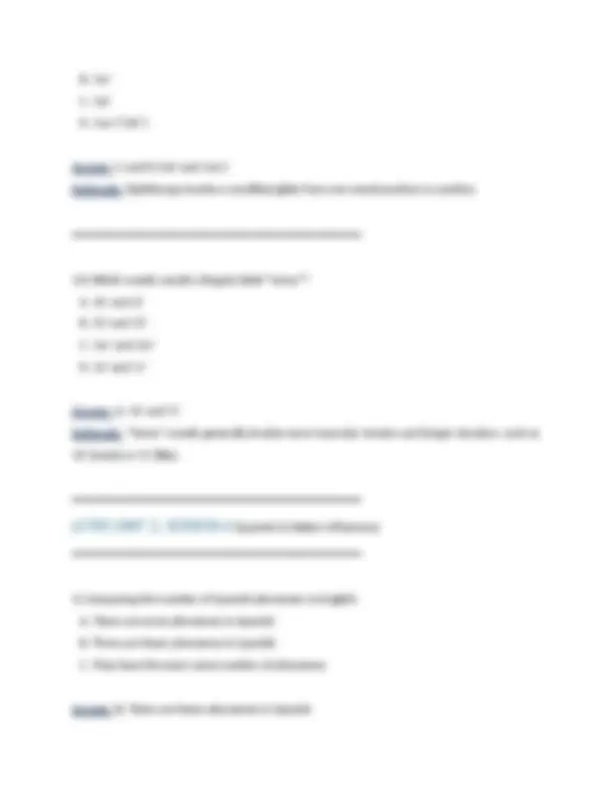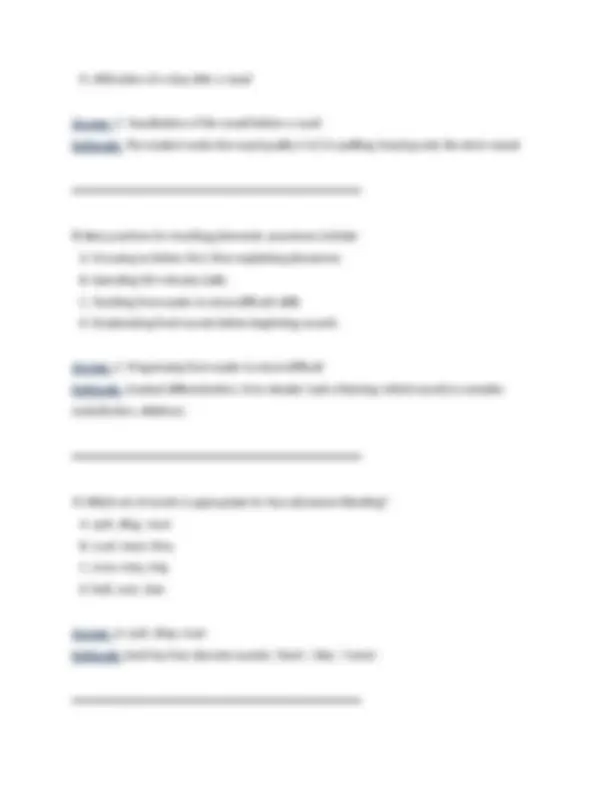Download (2025 / 2026) LETRS Unit 2 Sessions 1 to 8 Questions and Verified Rationalized Answers and more Exams Literature in PDF only on Docsity!
LETRS Unit 2 Assessment
- LETRS Unit 2 Session 1 –
- LETRS UNIT 2, SESSION 1........................................................................................................ Contents
- LETRS UNIT 2, SESSION 2........................................................................................................
- LETRS UNIT 2, SESSION 3......................................................................................................
- LETRS UNIT 2, SESSION 4......................................................................................................
- LETRS UNIT 2, SESSION 5......................................................................................................
- LETRS UNIT 2, SESSION 6......................................................................................................
- LETRS UNIT 2, SESSION 7......................................................................................................
- LETRS UNIT 2, SESSION 8......................................................................................................
- LETRS UNIT 2 ASSESSMENT..................................................................................................
LETRS UNIT 2, SESSION 1
- A student with general phonological awareness can learn to read fluently, even if the student has not yet developed awareness of speech sounds at the phoneme level. A. True B. False Answer: B. False Rationale: According to LETRS, students must become aware of individual phonemes to secure full phonics knowledge and achieve fluent reading. ━━━━━━━━━━━━━━━━━━━━━━━━━━━━━━━━━━━━━━━━
- If a student analyzes the sounds and syllables in a word, it is easier for the student to store the word in semantic memory. A. True B. False Answer: A. True Rationale: LETRS emphasizes that analyzing a word’s structure (syllables, phonemes) supports deeper encoding and more robust mental storage, aiding comprehension. ━━━━━━━━━━━━━━━━━━━━━━━━━━━━━━━━━━━━━━━━
- Which classroom activity targets only phonological awareness—without addressing other language skills? A. Ms. Jones says a word, has students repeat it, then asks them where they have heard it and what it means.
C. Matching the sound of a spoken word to its meaning D. Saying the phonemes within a syllable so they are seamlessly joined Answer: D. Saying the phonemes within a syllable so that all segments are seamlessly joined Rationale: Coarticulation is about how sounds overlap in real speech, producing continuous rather than strictly separated segments. ━━━━━━━━━━━━━━━━━━━━━━━━━━━━━━━━━━━━━━━━
LETRS UNIT 2, SESSION 2
- What level of phonological or phonemic awareness is demonstrated in this (first) activity? A. Early phonological awareness B. Basic phonemic awareness C. Advanced phonemic awareness Answer: A. Early phonological awareness Rationale: Early phonological awareness often pertains to skills such as rhyme, syllable counting, or identifying initial sounds in simpler tasks. ━━━━━━━━━━━━━━━━━━━━━━━━━━━━━━━━━━━━━━━━
- What level of phonological or phonemic awareness is demonstrated in this (second) activity? A. Early phonological awareness B. Basic phonemic awareness C. Advanced phonemic awareness Answer: B. Basic phonemic awareness
Rationale: Basic phonemic awareness involves simple blending or segmentation at the phoneme level (e.g., 2- or 3-phoneme words). ━━━━━━━━━━━━━━━━━━━━━━━━━━━━━━━━━━━━━━━━
- What level of phonological or phonemic awareness is demonstrated in this (third) activity? A. Early phonological awareness B. Basic phonemic awareness C. Advanced phonemic awareness Answer: C. Advanced phonemic awareness Rationale: Advanced skills typically involve manipulating (adding, deleting, substituting) phonemes within words. ━━━━━━━━━━━━━━━━━━━━━━━━━━━━━━━━━━━━━━━━
- What level of phonological or phonemic awareness is demonstrated in this (fourth) activity? A. Early phonological awareness B. Basic phonemic awareness C. Advanced phonemic awareness Answer: B. Basic phonemic awareness Rationale: This might show the student’s ability to isolate, segment, or blend simple consonant- vowel-consonant words. ━━━━━━━━━━━━━━━━━━━━━━━━━━━━━━━━━━━━━━━━
- What level is demonstrated in the fifth activity? A. Early phonological awareness
- What level is demonstrated in the eighth activity? A. Early phonological awareness B. Basic phonemic awareness C. Advanced phonemic awareness Answer: C. Advanced Rationale: An activity that requires more complex manipulation, beyond simple segmentation or blending. ━━━━━━━━━━━━━━━━━━━━━━━━━━━━━━━━━━━━━━━━
- Which phonological or phonemic awareness activity would you do next? A. Reverse phonemes: “Say ‘park.’ Now say ‘park’ backward.” B. Identify syllables: “How many syllables are in ‘fantastic’?” C. Identify which word does not belong in a set by first sound Answer: C. Identify which word does not belong… Rationale: This follows the simpler continuum of phonological tasks (e.g., alliteration), so it is appropriate if the student still needs that practice. ━━━━━━━━━━━━━━━━━━━━━━━━━━━━━━━━━━━━━━━━
- What would you do next? A. Segment phonemes in CVC words B. Substitute vowel phonemes C. Count syllables Answer: A. Segment CVC words
Rationale: Before moving to vowel substitutions or multi-syllable checks, the student should solidify segmenting basic CVC words. ━━━━━━━━━━━━━━━━━━━━━━━━━━━━━━━━━━━━━━━━
- What would you do next? A. Blend phonemes in CVC words B. Substitute phonemes C. Reverse phonemes Answer: B. Substitute phonemes Rationale: Substituting phonemes is usually a next step after consistent blending/segmenting, showing advanced phonemic manipulation. ━━━━━━━━━━━━━━━━━━━━━━━━━━━━━━━━━━━━━━━━
- Even after first grade, simple phoneme segmentation and blending of single-syllable words predicts reading ability. A. True B. False Answer: B. False Rationale: By second grade, students typically move to more complex phonemic tasks involving consonant clusters and phoneme manipulation as stronger predictors. ━━━━━━━━━━━━━━━━━━━━━━━━━━━━━━━━━━━━━━━━
- Students’ ability to develop phonemic awareness is NOT dependent on which factor? A. General language development
Rationale: By age 7, children commonly manipulate initial or final sounds in short words; removing an internal sound like /n/ in “sand” is often more advanced. ━━━━━━━━━━━━━━━━━━━━━━━━━━━━━━━━━━━━━━━━
- Which advanced/complex phoneme awareness skill is most difficult for children to master? A. Deleting a final sound from a CVC word B. Adding a sound to the beginning of a CCVC word C. Deleting the second phoneme in a CCVCC pattern D. Matching words with the same initial sounds Answer: C. Deleting the second phoneme in CCVCC Rationale: Removing a phoneme that is embedded inside multiple consonants is a high-level challenge in phoneme manipulation. ━━━━━━━━━━━━━━━━━━━━━━━━━━━━━━━━━━━━━━━━
LETRS UNIT 2, SESSION 3
- Phonemic awareness instruction for young learners is most beneficial when linked with phonics instruction. A. True B. False Answer: A. True Rationale: LETRS recommends integrating phonological awareness with decoding instruction to create a strong foundation for reading.
- The inventory of phonemes used in Spanish is nearly identical to English. A. True B. False Answer: B. False Rationale: Spanish and English differ in total phonemes; Spanish has fewer overall, which impacts instruction for Spanish speakers learning English. ━━━━━━━━━━━━━━━━━━━━━━━━━━━━━━━━━━━━━━━━
- A screening test measuring segmentation of three phonemes has the best predictive validity in which grades? A. Fourth or fifth B. Third or fourth C. First or second D. Kindergarten or first Answer: D. Kindergarten or first Rationale: Early tests of segmentation are highly predictive for K–1 literacy development. ━━━━━━━━━━━━━━━━━━━━━━━━━━━━━━━━━━━━━━━━
- How much phonological awareness training for maximum effectiveness? A. At least 45 minutes a day B. Once a week for ~30 minutes C. A few minutes a day, several days per week D. About 30 minutes each day
Rationale: Counting distinct phonemes requires careful attention to each sound spoken. ━━━━━━━━━━━━━━━━━━━━━━━━━━━━━━━━━━━━━━━━
- How many phonemes are heard? (Question #2) A. 2 B. 3 C. 4 D. 5 Answer: C. 4 Rationale: The spoken word likely has four separate sounds. ━━━━━━━━━━━━━━━━━━━━━━━━━━━━━━━━━━━━━━━━
- How many phonemes are heard? (Question #3) A. 2 B. 3 C. 4 D. 5 Answer: D. 5 Rationale: Some words with multiple consonant clusters can yield five distinct phonemes. ━━━━━━━━━━━━━━━━━━━━━━━━━━━━━━━━━━━━━━━━
- How many phonemes are heard? (Question #4) A. 2 B. 3
C. 4
D. 5
Answer: C. 4 Rationale: Multiple consonants can still combine into four discrete phonemes. ━━━━━━━━━━━━━━━━━━━━━━━━━━━━━━━━━━━━━━━━
- How many phonemes are heard? (Question #5) A. 2 B. 3 C. 4 D. 5 Answer: B. 3 Rationale: Despite spelling complexities, the word in question contains three pronounced sounds. ━━━━━━━━━━━━━━━━━━━━━━━━━━━━━━━━━━━━━━━━
- Which sound did you hear? (Question #6 - listed as #1 in that sub-set) A. /ch/ B. /s/ C. /sh/ D. /z/ Answer: B. /s/ Rationale: Carefully focusing on the hiss-like sound reveals /s/.
Answer: C. /z/ Rationale: /z/ is a voiced sibilant (like /s/, but with vocal fold vibration). ━━━━━━━━━━━━━━━━━━━━━━━━━━━━━━━━━━━━━━━━
- Which sound did you hear? A. /b/ B. /m/ C. /n/ D. /p/ Answer: D. /p/ Rationale: /p/ is an unvoiced bilabial stop. ━━━━━━━━━━━━━━━━━━━━━━━━━━━━━━━━━━━━━━━━
- Which sound did you hear? A. /g/ B. /k/ C. /n/ D. /ŋ/ Answer: D. /ŋ/ Rationale: /ŋ/ is a nasal produced in the back of the mouth (as in “sing”). ━━━━━━━━━━━━━━━━━━━━━━━━━━━━━━━━━━━━━━━━
- Which sound did you hear?
A. /f/ B. /l/ C. /r/ D. /w/ Answer: B. /l/ Rationale: /l/ is an “alveolar liquid” formed by placing the tongue tip behind the teeth. ━━━━━━━━━━━━━━━━━━━━━━━━━━━━━━━━━━━━━━━━
- Which nasal is formed with lips pressed together? A. /b/ B. /m/ C. /n/ D. /p/ Answer: B. /m/ Rationale: The /m/ sound is the only nasal requiring complete lip closure. ━━━━━━━━━━━━━━━━━━━━━━━━━━━━━━━━━━━━━━━━
- Which sound is the voiced counterpart to /ch/? A. /k/ B. /j/ C. /s/ D. /sh/ Answer: B. /j/ Rationale: /ch/ and /j/ share place/manner but differ in voicing.
D. Substituting an unvoiced fricative for a voiced one Answer: C. Confusing two voiced fricatives (/v/ and voiced /th/) Rationale: /th/ (voiced) and /v/ are often confused by learners, especially if they’re merging the sound with labiodental /v/. ━━━━━━━━━━━━━━━━━━━━━━━━━━━━━━━━━━━━━━━━
- A student writes “mob” instead of “mop.” The likely cause? A. Substituting a nasal for a stop B. Substituting a voiced stop for an unvoiced stop C. Confusing two different voiced stops D. Misunderstanding place of articulation Answer: B. Substituting a voiced stop for an unvoiced stop Rationale: /p/ is unvoiced, but the student used /b/ (voiced). ━━━━━━━━━━━━━━━━━━━━━━━━━━━━━━━━━━━━━━━━
- In many instances, two different consonants in English share the same mouth position, but one is voiced and the other is unvoiced. A. True B. False Answer: A. True Rationale: Pairs like /p/–/b/, /t/–/d/, /k/–/g/ illustrate this point, known as minimal pairs by voicing. ━━━━━━━━━━━━━━━━━━━━━━━━━━━━━━━━━━━━━━━━
- Adults often miscount phonemes because they recall word spelling and count letters instead. A. True B. False Answer: A. True Rationale: Orthography can mislead us; for instance, a single letter may represent multiple sounds or a group of letters might represent a single sound. ━━━━━━━━━━━━━━━━━━━━━━━━━━━━━━━━━━━━━━━━
- Which sound is an affricate (combining features of fricatives and stops)? A. /k/ B. /ŋ/ C. /tʃ/ (“ch”) D. /ʒ/ (“zh”) Answer: C. /tʃ/ Rationale: An affricate begins with a stop and is released as a fricative. ━━━━━━━━━━━━━━━━━━━━━━━━━━━━━━━━━━━━━━━━
- Which of the following pairs are consonant sounds that students frequently confuse? (Select all that apply.) A. /t/ and /d/ B. /f/ and /p/ C. /m/ and /n/ D. /z/ and /l/






































































































